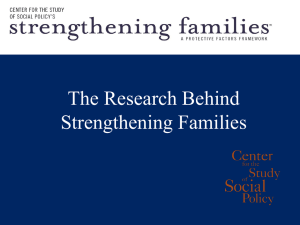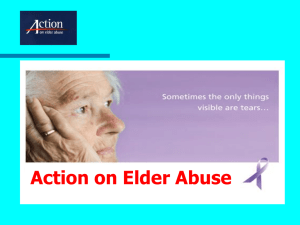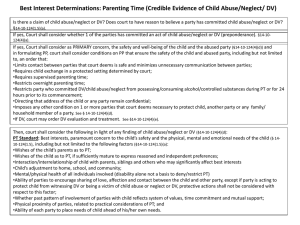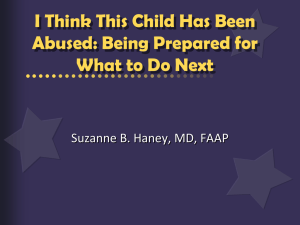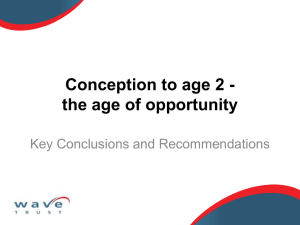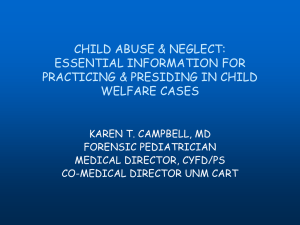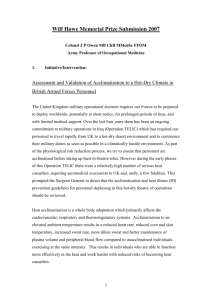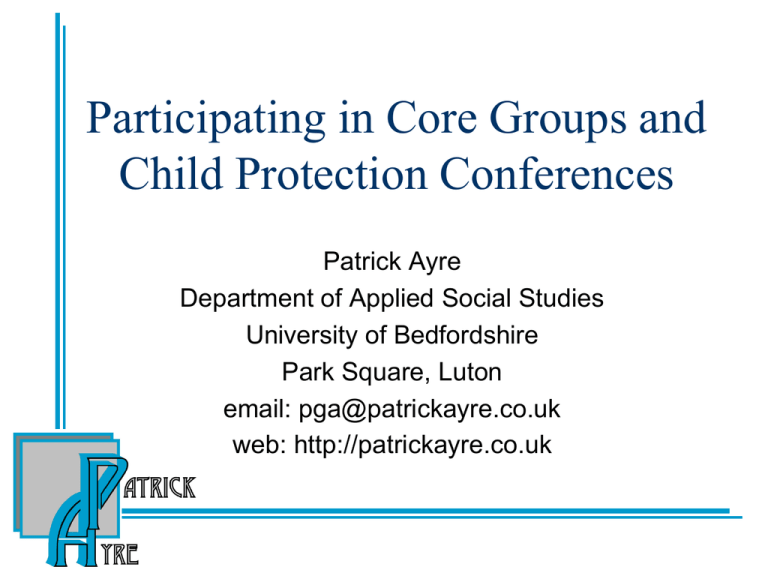
Participating in Core Groups and
Child Protection Conferences
Patrick Ayre
Department of Applied Social Studies
University of Bedfordshire
Park Square, Luton
email: pga@patrickayre.co.uk
web: http://patrickayre.co.uk
Objectives
To gain awareness of the procedures when referring
a child or young person to Children’s Services
To understand your role and responsibilities when
attending core groups and child protection reviews
To gain knowledge on how to compile a professional
report for child protection conferences
To gain understanding of the interagency frameworks
and child protection assessment processes, including
the use of assessment frameworks
Typical natural history of a case
Abuse or cause for concern identified
Consultation/discussion within agency
Referral Initial Assessment
Typical natural history of a case
Multi-agency strategy discussion to plan
co-ordinated action
Investigation (s47 or Core Assessment)
Child protection conference to plan
further action
Initial child protection conference
“Where the agencies most involved judge that a
child may continue to, or be likely to, suffer
significant harm local authority children’s social
care should convene a child protection
conference”.
“The aim of the conference is to enable those
professionals most involved with the child and
family, and the family themselves, to assess all
relevant information and plan how best to
safeguard and promote the welfare of the child”.
Working Together 2010
Initial child protection conference
Brings together and analyses information obtained
about the child’s developmental needs and the
parents’ capacity to respond to these needs to
ensure the child’s safety;
Considers evidence presented to the conference,
taking into account present situation, family history
and present and past functioning;
Decides whether the child is continuing to, or is likely
to, suffer significant harm;
Decides future action required to safeguard and
promote welfare, including need for child protection
plan, planned developmental outcomes for the child
and how best to intervene to achieve these.
Review child protection conference
Review whether the child is continuing to
suffer, or is likely to suffer, significant
harm;
Review health and developmental
progress against planned outcomes in the
child protection plan;
Ensure that the child continues to be
safeguarded from harm; and
Consider whether the child protection plan
should continue or should be changed.
Discontinuing a plan
No likelihood of significant harm;
Child has moved away;
Child has reached 18 or has died.
Core group
Led by named keyworker;
Include the child if appropriate, family
members, and professionals or foster
carers working with the family.
Arrange for the provision of appropriate
services whilst awaiting assessment(s);
Develop the child protection plan as a
detailed working tool, and implement it;
Core group
Monitor progress against objectives specified
in the plan;
Provide a forum for negotiating and working
parents, wider family members, and children;
Meet for first time within 10 working days of
the initial child protection conference;
Then meet often enough to facilitate working
together, monitor actions and outcomes, and
make any alterations required.
Core group
Each member is jointly responsible
Key worker has the lead role.
Use information about the family’s history and
functioning to inform decision making
Keep the focus on the child
Ensure child is seen alone where appropriate
Attend to welfare, wishes and feelings,
Understand the daily life experience of the
child and its meaning to them
A child centred approach
The purpose of assessment is to understand
what it is like to be that child (and what it will be
like in the future if nothing changes)
Checkpoint: Core group research
What do social workers say about other
professionals?
What do other professionals say?
Core group: What do social workers
say about other professionals?
Have lower tolerance of risk
Unwilling to share responsibility and chores even
when social worker new or under pressure
Anxious or less than enthusiastic about getting
involved
Try to do the business outside meeting, away
from parents; afraid of parents
Sometimes focused on parents instead of child
(mirroring)
What do other professionals say?
Greater knowledge disregarded and
decisions overturned without
consultation
Trust difficult because of turnover
Not always possible to be open with
parents
Resented demands when peripheral
Mental health or drugs issues
Working on the same case but not working
jointly
Mutual incomprehension and
misunderstanding
False expectations and assumptions
Abdicating responsibility
Need for ‘interpreters’
Multi-agency meetings
Collusion vs conflict
Inclusion vs exclusion
Facilitation vs determination
Multi-agency meetings
Closed or open groups?
Polarisation
Exaggeration of hierarchy
(Reder et al., 1993)
Multi-agency meetings: groupthink
Shared rationalisations to support the
first adequate alternative suggested by
an influential group member;
A lack of disagreement;
An illusion of infallibility;
Negative stereotypes of outsiders;
Direct pressure on dissenters.
Multi-agency meetings: groupthink
May appear late in conference;
Outcome determined by information and
perspective of social worker;
Group ineffective in challenging risky
decision making;
Escalation of commitment and selfjustification
Hard to interrupt once symptoms present
Kelly and Milner (1996)
Conference problems
Attendance at conferences
Protection plans omit objectives and
outcomes
Removal from the register
Response to overload
Acclimatisation at individual, team,
agency and geographical levels
Lack of a strategic multi-agency
response
Checkpoint: Acclimatisation
Is acclimatisation present in any
aspect of your work?
What could you/do you do about it?
The Child Safeguarding System
(nominal)
The Child Safeguarding System
(actual?)
Reporting to the Conference
Two main purposes:
To help the conference to decide if
there are grounds for making a CP plan
To help to decide what the plan should
be
Social worker’s report to conference
Chronology of significant events;
Child’s current and past developmental
needs;
Capacity of the parents to ensure the child
is safe from harm, and to respond to
developmental needs;
Family history and current and past
functioning;
Wishes and feelings of the child, parents
and other family members;
Social worker’s report to conference
Analyses Assessment Framework
information
– Child’s strengths and difficulties;
– Parenting strengths and difficulties;
– Family and environmental factors;
– Effect of parenting on the child’s health and
development.
Includes the local authority’s
recommendations
Reports of other professionals
Details of involvement with the child and
family;
Knowledge of child’s developmental needs;
Capacity of parents to meet these needs;
Impact of current and past functioning and
family history on the parents’ capacities;
Wherever possible written report in advance.
Reporting to the Conference
May seem like a chore BUT:
Can get everything down (less risk of forgetting
something or missing it out)
You can check the information and make sure it is
accurate.
You can spend time thinking about how you
express things
The conference and the other parties will read in
advance, so may have less time speaking:
– Should only be asked about disputed parts of the
report
– Those with a different view may not need to ask
questions or may even fold!
Selling you opinion
What would you look for
yourself?
Selling you opinion
Presentation
Content
Presentation
Make it pretty and easy to read
– Neat
– Double spaced
– One side only
– Numbered paragraphs and pages
Language
Good grammar
Good sentence construction
Simple sentences
No unnecessary, unexplained jargon
Appropriate tone (formal so no slang, no
contractions, no use of first names for
adults)
Sensitively phased (but not watered
down)
Content problems
Incomplete
Biased
Conclusions and recommendations
poorly argued and justified (or absent
altogether)
What do they want to know?
Who you are
Why you are reporting
The facts of the case
The conclusions to be drawn from the
facts
Introduction
Qualifications & current employment
Experience and expertise
How long involved with family and
capacity
Purpose of report
Sources of information from which the
report is compiled
The chain of reasoning
Facts
Analysis/summary
Conclusions and recommendations
The facts
‘It is the task of practitioners to share,
sift, search for and weigh the
significance of their information’
(Morrison 2009)
The facts
Family composition (attach a genogram)
Background history (family and
individual)
Recent events
The facts
Tell the story chronologically without too
much editorialising
Facts sufficient support your argument and
also to refute counter arguments
First hand evidence is best but give source of
any information
Make sure that you have put information as
fully and accurately as possible (Checklist:
Who, what, when, where, how)
Bias and Balance
Include information favourable to ‘the
other side’ as well as that favourable to
yours
It is your job to make judgements but:
– avoid empty evaluative words like
inappropriate, worrying, inadequate
– Give evidence for descriptive words like
cold, dirty and untidy
Beware the danger of facts
Bias and Balance
Born in 1942, he was sentenced to 5
years imprisonment at the age of 25. After
5 unsuccessful fights, he gave up his
attempt to make a career in boxing in
1981 and has since had no other regular
employment
Lies, damned lies and killer bread
Research on bread indicates that
More than 98 percent of convicted felons are bread users.
Half of all children who grow up in bread-consuming
households score below average on standardized tests.
More than 90 percent of violent crimes are committed within
24 hours of eating bread.
Primitive tribal societies that have no bread exhibit a low
incidence of cancer, Alzheimer's, Parkinson's disease, and
osteoporosis.
In the 18th century, when much more bread was eaten, the
average life expectancy was less than 50 years; infant
mortality rates were unacceptably high; many women died in
childbirth; and diseases such as typhoid, yellow fever, and
influenza were common.
Incomplete or out of date
Can you trust a snapshot?
Collecting and interpreting information
Importance of comprehensive family
assessments, especially male figures
Need for medical evidence to be
considered within the overall context
Understanding thresholds, especially the
importance of neglect and emotional
deprivation and the need to accumulate
evidence
Capturing chronic abuse
Judging the impact of long-term abuse is an
essential component of any assessment but
how well do we do it?
Judgements subjective and prone to bias
Intangible: Difficult to capture and compare
High threshold for recognition
Neglect is a pattern not an event
Capturing chronic abuse
Judging the quality of care is an essential
component of any assessment but how well
do we do it?
Judgements subjective and prone to bias
Intangible: Difficult to capture and compare
High threshold for recognition
Neglect is a pattern not an event
Our image of assessment
Assessment
The reality of assessment?
Assessment
Capturing chronic abuse
Judging the quality of care is an essential
component of any assessment but how well
do we do it?
Judgements subjective and prone to bias
Intangible: Difficult to capture and compare
High threshold for recognition
Neglect is a pattern not an event
The pattern of neglect: atypical
The pattern of neglect: typical
Intervention
Intervention
The pattern of neglect
'Good enough' level
Intervention
Intervention
The pattern of neglect
Intervention ceases
'Good enough' level
Intervention
Intervention
The pattern of neglect
What we would hope to find
S
E
X
U
A
L
A
B
U
S
E
P
H
Y
S
I
C
A
L
A
B
U
S
E
N
E
G
L
E
C
T
N
E
G
L
E
C
T
N
E
G
L
E
C
T
Threshold for
intervention
What we found
S
E
X
U
A
L
A
B
U
S
E
Threshold for
intervention
P
H
Y
S
I
C
A
L
A
B
U
S
E
N
E
G
L
E
C
T
N
E
G
L
E
C
T
N
E
G
L
E
C
T
N
E
G
L
E
C
T
What we found
Chronic abuse and the principle of
cumulativeness
Incidents scattered through files
The problem of proportionality
Acclimatisation
Assessment Pitfalls
When faced with an aggressive or frightening
family, professionals are reluctant to discuss
fears for their own safety and ask for help
Attention is focused on the most visible or
pressing problems and other warning signs are
not appreciated
Parents’ behaviour, whether co-operative or
uncooperative, is often misinterpreted
Not enough weight to information from family
friends and neighbours
Not enough attention is paid to what children
say, how they look and how they behave
In Cleaver, H, Wattam, C and Cawson, P Assessing Risk in Child Protection,
NSPCC, 1998
Information handling
Picking out the important from a mass of
data
Interpretation
Decoyed by another problem
False certainty; undue faith in a ‘known fact’
Discarding information which does not fit
First impressions/assumptions
Too trusting/insufficiently critical
Distinguishing fact/opinion
Department of Health (1991) Child abuse: A study of inquiry reports, 19801989, HMSO
Fact or opinion?
There are inadequate play and stimulation
opportunities available.
2. The bruise and swelling are consistent with hitting his
head on the door.
3. This is the first incident of abuse to the child.
4. The flat is unsuitable for bringing up a young child.
5. Mrs Green is good at keeping her flat tidy.
6. Experienced professionals are better at dealing with
child protection issues.
7. Children who were abused usually become abusers.
8. The child said his dad hit him.
9. I saw Peter playing with his toys when I last visited.
10. Mrs Green does not display appropriate parenting skills
when relating to her son
1.
The chain of reasoning
Facts
Analysis/summary
Conclusions and recommendations
Analysis
Studies (and SCRs) highlight problems
in the quality and level of analysis
Assessments too static and descriptive,
resulting in an accumulation of facts that
are not analysed in a way that offers an
explanation of the situation (Brandon
2008)
But what is analysis?
You have gathered lots of information but now
what?
All you need to do is ask yourself my favourite
question:
“So what?”
You have collected all this data, but what does
this mean, for the young person, for the family
and for the authority?
Analytic thinking
‘a conscious and controlled process using
formal reasoning and explicit data and rules
to deliberate and compute a conclusion’
(Munro, 2007)
‘Analysis should be seen as acting like a
good secretary keeping a check on the
products of intuition, checking them for known
biases, developing explanatory theories and
testing them rigorously’ (Thiele, 2006)
Intuition and Analysis
Intuitive thinking – unconscious process that
allows the integrations of a large amount of
information to produce a judgement in an
effortless way
Gut feelings: ‘take advantage of the evolved
capacity of the brain and are based on rules
of thumb that enable us to act fast and with
astonishing accuracy’ (Gigerenza, 2007)
Intuition versus Analysis
It is the combination of intuitive and
analytic modes that produces the kind of
evidence-based practice by which social
work knowledge establishes its relevance,
expertise and authority
Morrison 2009
Risk assessment
The dangers involved (that is the feared
outcomes);
The hazards and strengths of the situation (that is
the factors making it more or less likely that the
dangers will realised);
The probability of a dangerous outcome in this
case (bearing in mind the strengths and hazards);
The further information required to enable this to
be judged accurately; and
The methods by which the likelihood of the feared
outcomes could be diminished or removed.
The chain of reasoning
Facts
Analysis/summary
Conclusions and recommendations
Conclusions and recommendations
Summarise the main issues and the
conclusions to be drawn from them. (The
facts do not necessarily speak for
themselves; it is your job to speak for them.)
Define objectives as well as actions
Draw conclusions from the facts and
recommendations from the conclusions
Explain how you arrived at your conclusions
(Have you demonstrated the
factual/theoretical basis for each?)
Consider and discuss alternative possibilities
Conclusions and recommendations
In particular:
Whether you think a plan should be made
(referring to the official criteria)
Relevant recommendations (mainly relating
to your own service)
Conclusions and recommendations
In drawing conclusions be aware of the
extent and limitations of your own expertise.
Conclusions may be supported by research
Your recommendation should usually be
specific (not either/or)
Remember: conclusions may be attacked in
only two ways
– founded on incorrect information
– based on incorrect principles of social work
What is good use of research?
Relevance, and applicability (including fit,
where conducted, age, culture);
Reliability and validity;
Credibility of source;
Be careful with new or controversial theories;
Be aware of and address counter arguments;
Don’t go outside your expertise.
Conclusions and recommendations
Problems:
Unsupported assertions or judgements
Inability or unwillingness to analyse and
draw conclusions
Failure to answer the key question:
‘So what?’
Reaching a decision
‘Often a decision is made first and the
thinking done later’ (Thiele, 2006)
As humans, we resort to simplifications, short
cuts and quick fixes!
We reframe, interpret selectively and
reinterpret.
We deny, discount and minimise
We exaggerate information especially if vivid,
unusual, recent or emotionally laden and
We avoid, forget and lose information
Good Assessments
Are clear about the purpose, legal status and
potential outcomes
Are based on a clear theoretical framework
Are clear about context and value base
Are collaborative and promote accessibility
for service users
Are based on multiple sources of information
Value the expertise and understanding
service users bring to their situation
Are clear about missing information
Good Assessments
Identify themes and patterns about needs, risks,
protective factors and strengths
Generate and test different ways of understanding
the situation
Give meaning to themes, using knowledge based on
experience/research
Lead to an evidence-based conclusion
Use supervision to assist reflection, hypotheses and
objectivity
Are able to record and explain outcomes
Are reviewed, updated & amended in light of new
information
Spotting the bad ones: Organisational Clues
Mythology exists about the family – ‘this
family is/always/behaves like
Negative stereotypes about other agencies
exist so their information is discounted
Sudden changes about view of risk not
explained
Sudden changes of plan not rationally
explained
Worker clues
Gut feelings says something is wrong
Worker does not ask difficult questions
Analysis does not account for facts/history
Proposed plan does not address issues
raised in assessment
Practitioner is working much harder than the
parents to explain significant concerns
The child’s story is missing
Inter-Agency Clues
Agencies have conflicting views of the
family/risk
Agencies have strong views but offer
ambiguous/limited evidence
Some agencies unwilling to share
information
Pressure to agree suppresses
permission to question / inter-agency
acclimatisation
Family Clues
Parental intentions not supported by actions
Parental optimism involves denial of
difficulties
Children's accounts conflict with parents’
Parents’ ‘talk’ about their child is
contradictory/lacks coherence
Co-operation is only on the parents’ terms
Assessment frameworks
Common Assessment Framework (CAF)
Framework for the Assessment of Children in
Need and their Families
– Initial Assessment
– Core Assessment
What is CAF
“The CAF is a shared assessment and planning
framework for use across all children’s services
and all local areas in England. It aims to help
the early identification of children and young
people’s additional needs and promote coordinated service provision to meet them”
What does CAF consist of?
A pre-assessment checklist
A multi-agency assessment process
A standard form for assessment, planning
and review
When to do one?
Any time you are worried about a child’s progress
towards the five ECM priority outcomes
What does it consist of?
A pre-assessment checklist
A multi-agency assessment process
A standard form for assessment, planning
and review
Consent form
Framework for the Assessment…
“This Framework must be used by Children’s
Services in any assessment of a Child in
Need and his/her family, to which all partner
agencies will contribute as appropriate”.
It “provides a systematic basis for collecting
and analysing information to support
professional judgements about how to help
children and families in the best interests of
the child”.
Framework for the Assessment…
Initial Assessment…
“a brief assessment of each child referred to
social services with a request for services to
be provided”
Maximum of 7 working days
Uses Framework to determine:
– whether the child is in need,
– the nature of any services required
– Whether core assessment should be undertaken.
Core Assessment…
“an in-depth assessment which addresses
the central or most important aspects of the
needs of a child and the capacity of his or her
parents or caregivers to respond
appropriately to these needs within the wider
family and community context”.
Led by social services, but
Will invariably involve other agencies
Bonus material: Specific problems
Hesitancy in challenging
Hostile and ‘difficult to engage’ families
‘Start again syndrome’.
Very young children physically assaulted
known to universal services or adult services
rather than children’s social care
Well over half: domestic violence, or mental ill
health, or parental substance misuse
‘Hard to help’ young people
“Hard to Help”: The complexity of the
challenge
Young people may be
Victims,
Perpetrators
Parents
Any combination of the above
but have the same right to be
safeguarded as any other child.
The background
“The reviews showed that state care did
not always support these young people
fully and that they experienced ‘agency
neglect’” Brandon and others (2008).
The young people (Brandon and others)
History of rejection, loss and, usually,
severe maltreatment
Long term intensive involvement from
multiple agencies
Parents: history of abuse and current
mental health and substance issues
Difficult to contain in school
Typically self-harming and misusing
substances, often self-neglect
The young people (Brandon and others)
Numerous placement breakdowns
Running away, going missing
Risk of dangerous sexual activity
including exploitation
Sometimes placed in specialist
settings, only to be withdrawn because
of running away
The young people (My experience)
Long involvement, but not always intense
Sometimes few placements, but all wrecked
by the young person
Common factor that local services just did
not know what to do with them.
‘By the time of the incident, for many of the
young people, little or help was being
offered because agencies appeared to have
run out of helping strategies’ (Brandon and
others, 2008).
The response
Reluctance to identify mental illness and
suicidal intent (CAMHS)
Failure to respond in a sustained way to
extreme distress manifested in risky
behaviour (sex, drugs, suicide attempts)
Instead of ‘pulling together’, multi-agency
response shows fragmentation, ignoring,
responsibility shifting, freezing/inertia and
generally avoidant behaviour
Reasons for running not addressed
adequately
The response
Running away leads to discharge
[More generally, does rejection of
services lead to total abandonment?]
Age used as a reason for not imposing
services
No proper assessment of competence;
allowed/forced to choose
[Dealing with incidents but failing to
recognise patterns]
The obstacles
Hard to get a purchase on the system
Wrong children, wrong adults (Ayre, 2000)
Lack of off-the-shelf resources
The limited resources are poorly
coordinated and integrated
Government targets not child centred or
child driven
Different agency agendas and mutual
misunderstanding; falling down the gap
The solutions?
Biehal (2005) recommends adolescent
support teams in the community [but is
that enough?]
The complexity of the challenge
requires flexible collaborative,
individualised responses built around
the young person
Specialist assessment and treatment?

